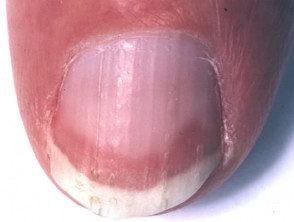What is a white nail?
Nail They are generally pink in color. A white nail describes the appearance of one or more fingernails and/or toenails that are partially or completely white in color. This appearance is also called leukonychia.
Classification of white nails
Total leukonychia is a whitening of the entire nail plate.
- Plush nails are white with reddened or dark tips.
Partial leukonychia has 3 subtypes:
- Stippled leukonychia: small white spots
- Longitudinal leukonychia: longitudinal band of white nail
- Striated or transverse leukonychia: one or more white horizontal bands across the entire nail parallel to the lunula, and are also called Mees lines.
Muehrcke's lines are a form of apparent transverse leukonychia due to variable blood flow under the nail; pressure on the nail plate makes them disappear. Vitiligo or leukoderma (white skin) may also cause apparent partial or longitudinal leukonychia.
Partial leukonychia

Striated leukonychia due to chemotherapy

Punctate leukonychia of unknown cause

Apparent leukonychia due to vitiligo
Who gets a white nail?
White nails can affect anyone: men and women of any age or ethnicity.
What causes a white nail?
Trauma
The nail plate can be damaged in part or in whole by injuries to the nail plate or matrix (growth area at the base of the nail). Disruption of the horizontal layers of curb, with air trapping, results in reflection and lack of transparency.
Types of injuries that cause punctate leukonychia include nail biting, manicures, bumps and bruises, and tight footwear. The white spots grow as the nail grows (about 6 to 9 months for a nail). Striated leukonychia may follow damage to the nail matrix, and grooves and ridges may also appear on it. Total leukonychia may be followed by a more severe lesion, often with detachment of the nail plate from the nail bed and alteration of the nail contour.
Truncated leukoderma due to trauma

Dotted leukonychia

Dotted leukonychia

Dotted leukonychia
Poisoning and drugs
White nails can be caused by:
- Heavy metal poisoning (e.g. lead, arsenic)
- Chemotherapy
- Sulfonamides.
Leukonychia associated with chemotherapy

Chemotherapy-induced leukonychia

Striated leukonychia during chemotherapy

Chemotherapy-induced leukonychia
Hereditary disorders
- Longitudinal leukonychia is sometimes associated with Darier disease, which can also cause erythronychia (a red band).
- Total leukonychia also sometimes runs in families.
- Striated leukonychia may be due to inherited conditions that affect keratinization.
Systemic disease
Plush nails have been associated with:
- Liver cirrhosis
- Chronic kidney disease
- Heart failure
- Protein malabsorption, e.g. Ex. in colitis
- protein losing enteropathy
- Diabetes
- Lack of iron anemia
- zinc deficiency
- Hyperthyroidism
plush nails

plush nails

plush nails

Terry 1
Infection
Superficial white onychomycosis is an irregular type of partial leukonychia due to chronic fungal infection due to dermatophyte, Trichophyton interdigitale.
Superficial white onychomycosis

Superficial white onychomycosis 1

Superficial white onychomycosis 2

Superficial white onychomycosis 3
Skin illness
Leukonychia may be due to inflammatory skin disease affecting the nail matrix, most commonly nail or hand psoriasis eczema.
White nail: psoriasis

Psoriatic nail dystrophy
Differential diagnosis
Leukonychia must be distinguished from onycholysis, in which the nail plate appears white or yellowish because it has been lifted from the underlying nail bed.
Research
If the cause of leukonychia is unclear, the following tests may be helpful.
- Nail clippings for mycology
- A biopsy
- Blood tests to evaluate systemic disease. especially low albumin levels
What is the treatment for a white nail?
Treatment depends on the underlying cause of leukonychia.
What is the result for a white nail?
Leukonychia due to minor trauma or medication may resolve completely within a few months. In other cases, the white nail plate remains long-term or becomes recurrent.

